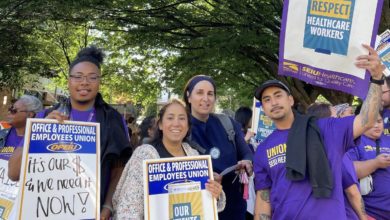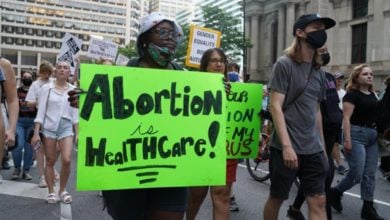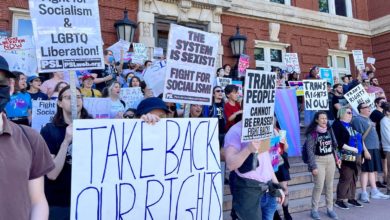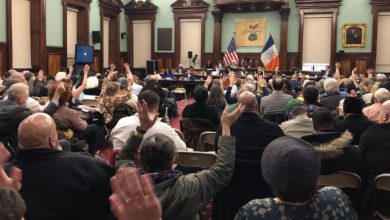
The following is based upon a talk given by Nadia Marsh, MD, at a recent New York City PSL forum. Dr. Marsh works in geriatrics and family health.
The U.S. is now the epicenter of the COVID-19 pandemic, with more cases than any country in the world. This virus has revealed the U.S. health care system to be a sham. We are the least prepared of any industrialized nation. Our for-profit health care system violates the underpinnings of public health, that is, fairness, equity, prevention, and health care as a right. We have the worst health care indices of any industrialized country. There are 30 million uninsured, no universal health care, and the most expensive and inefficient system in the world.
In the past decade there has been a series of pandemics affecting over a billion-and-half people– SARS, Ebola, MERS, H1N1, and others. Based on this trend, more were expected. Trump eliminated the National Security Council surveillance unit specializing in pandemics in 2018, even though our government was warned that another viral threat would be coming.
The U.S. had two months to prepare, but didn’t stock test kits or supplies
In December 2019, when COVID-19 presented in China, the United States was warned that we would be affected. Instead of ramping up our arsenal of test kits, N95 masks, and other personal protective equipment, Trump lied repeatedly about the severity of health threat. He ignored public health experts, and even ridiculing them.
It was only the stock market and corporations that the Trump administration cared about, and bad news about viruses impacts investor confidence. Two months went by with no plan to fortify medical supplies or develop a public health workforce. The Trump administration chose not to act, allowing the virus to spread.
Within days of the virus outbreak, both China and South Korea, tested tens of thousands of people, and put into place well-developed contact tracing and quarantines that saved millions of lives. China, with a population of one-and-a-half-billion people, was able to effectively stop the spread of the virus this month.
China provided paid leave, food delivery, job security
China sent over 1,000 small public health teams to interview patients and the people who potentially had contact with them when they were contagious. The Chinese government ensured that people who were quarantined had paid leave, job security and food from local restaurants, brought safely to their doorstep. In every apartment complex, temperatures were taken of people coming and going. Hand sanitizer was available to all. They even developed no-touch mechanisms for pressing elevator buttons to decrease contamination. In Wuhan, 16 temporary hospitals were put together within two weeks. Businesses were given strict safety guidelines that were reinforced to keep workers safe.
Poor health of U.S. population is a risk factor
COVID-19 is spread by respiratory droplets, usually from coughing, sneezing, or saliva. Some studies indicate that the virus may even remain floating in the air in aerosolized tiny particles for up to three hours. It can also survive on hard surfaces for days. The virus is six-to-ten times more deadly than the Influenza A virus. Its overall mortality is between 1-3%. The elderly have the highest risk of dying, those over 80 have a mortality of 15-20 percent.
Decreasing the chain of transmission
A new report by the Centers for Disease Control and Prevention shows that 40% of patients hospitalized for COVID-19 in the U.S. are between the ages of 20 and 54. This may reflect the fact that Americans as a whole are less healthy than many people in other developed countries, and often have chronic disease, including asthma, diabetes, and hypertension. All of this increase vulnerability to COVID-19. There is evidence that obesity itself increases risk too. Up to 70 percent of adults in this country are overweight, and 40 percent are morbidly obese. Poor immunity is common in this country, and a reflection of the way we live in capitalist America. COVID-19 takes advantage of people with weak immune systems. Poverty, lack of access to healthy foods, and high stress levels puts us at risk.
To decrease the chain of viral transmission, social distancing is necessary. That means remaining at least 6 feet away from another person, avoiding public places or touching surfaces that have been touched by others. In New York City social distancing was instituted very late, and because of the shortage of test kits we missed opportunities to identify cases and trace contacts. Test kits could have been supplied by the World Health Organization. Trump instead wanted a U.S.-made test. The companies could not develop the test kits fast enough, nor did they have the expertise.The virus has now spread so thoroughly in this city that sheltering in place is the only option.
Emergency preparedness deemed not profitable
New York City is now the epicenter of the COVID-19 in this country, with 40 percent of all cases. ICU beds are filling up quickly, hospitals are expected to run out of personal protective equipment this week, including N95 masks and gowns. These things are not available because the maintenance for emergency preparedness is not profitable. Stockpiles of emergency equipment necessary for a pandemic are lacking, including the 15,000 ventilators that New York City urgently now to keep people alive. Hospitals here don’t have the ability to stock up on ventilators that cost $50,000 each because they will be useless after the epidemic. This equipment loses its value in a capitalist society, as ventilators make no money sitting idle in storage.
A socialist health care system would have centralized leadership over disaster planning, and ensure that health care workers have the equipment they need to care for patients safely. As health care workers, we are all at risk, reusing N95 masks, or even worse, not having access to masks or other protective gear at all.
My colleagues who are front office staff, medical assistants, nurses, and paramedics are the hardest hit. Many are working without any masks or any protective equipment at all. These things, they are told, are reserved for “special situations.” Health care workers are contracting the virus at a rapid rate.
The health care system was already unsafe even before this pandemic. Nursing shortages, high turnover due to burnout, and focus on “productivity” rather than patient care has destroyed our ability to ramp up effectively for this crisis.
The government is suddenly speaking the language of public health–social distancing and hand washing–all of which is vital, but this is extraordinarily hypocritical. This public health messaging began two months after it should have.
The cruelty of capitalism is all around us. The lack of support for the many thousands now without jobs will further exacerbate this pandemic. Tens of thousands, possibly hundreds of thousands of New Yorkers are being laid off without guarantees to health care, housing, food, or income. Social distancing is more than challenging if people don’t have their basic needs met.
How does a homeless or incarcerated person ensure social distancing? Or someone waiting for services, or on a soup kitchen line? In my neighborhood, the delivery men stand in lines inches from one another, to pick up the take-out food they will bring us. Amazon workers load hundreds of boxes without protective gear, and Whole Foods workers engage throngs of people without protection or adequate breaks. Most have no health insurance, or sick pay.
At the same time, Big Pharma will make a killing while people are dying. They are competing for the rights to the COVID-19 vaccine, the ultimate prize of this pandemic. It is our tax dollars that funded the basic science research that the vaccine will be based on.
Cuban example of pubic health medicine, emergency preparedness
I look to Cuba as an example of what is possible in public health and medicine. After the Cuban revolution a new type of medical care was developed based on the model of neighborhood clinics, and family medicine that guarantees health care to all. A health care team lives in every neighborhood; they know their patients and families well, which means they can develop real and longstanding relationships that focus on prevention and wellness. They can spot problems quickly in their communities and are ready to respond when there is an emergency.
Cuba has emergency preparedness. It is able to evacuate entire cities during a hurricane. In 2016, Hurricane Mathew killed dozens of Americans and hundreds of Haitians. Not a single Cuban died. They fought Ebola effectively in West Africa in 2014.
Since the Cuban socialist revolution, 100,000 Cuban doctors have worked internationally in hundreds of countries to address epidemics and natural disasters. In fact right now, 52 Cuban health professionals, some with experience combating Ebola in Africa, are arriving in Lombardi, Italy, to help fight COVID-19.
We are now confronted with two options: one is to continue the private market-based health care system, where health is a commodity, ventilators cost $50,000 each, and are not even available during a time of need. Or we can take another path, a socialist path, where health care is free, and there for the people.
“The life of a single human being is worth millions of times more than all of the properties of the richest man on earth,” Che Guevara.





